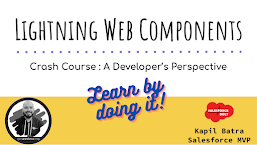If you ever had a requirement to navigate between flow screens from a Lightning Web Component, then this blog is for you.
In this blog you will learn -
✏️ Create Lightning Web Component for Flow.
✏️ Create Sections in Flow.
✏️ Get Available Actions for Flow.
✏️ Navigate between screens in Flow.
First I will create a LWC which will import FlowNavigationBackEvent and FlowNavigationNextEvent from flowSupport.
The lightning/flowSupport module provides events that enable a component to control flow navigation and notify the flow of changes in attribute values.
The events are supported only in components where the target is lightning__FlowScreen.
Events include:
FlowAttributeChangeEvent — Informs the runtime that a component property has changed.
FlowNavigationBackEvent — Requests navigation to the previous screen.
FlowNavigationNextEvent — Requests navigation to the next screen.
FlowNavigationPauseEvent — Requests the flow runtime to pause the flow.
FlowNavigationFinishEvent — Requests the flow runtime to terminate the flow.
HTML
1 2 3 4 5 6 7 | <template> <lightning-button label="Back" onclick={handleBack}> </lightning-button> <br /> <br /> <lightning-button label="Next" onclick={handleNext} variant="brand"> </lightning-button> </template> |
JS
1 2 3 4 5 6 7 8 9 10 11 12 13 14 15 16 17 18 19 20 | import { LightningElement, api } from "lwc";
import {
FlowNavigationBackEvent,
FlowNavigationNextEvent
} from "lightning/flowSupport";
export default class LwcForFlow extends LightningElement {
@api availableActions = [];
handleNext() {
if (this.availableActions.find((action) => action === "NEXT")) {
const navigateNextEvent = new FlowNavigationNextEvent();
this.dispatchEvent(navigateNextEvent);
}
}
handleBack() {
if (this.availableActions.find((action) => action === "BACK")) {
const navigateBackEvent = new FlowNavigationBackEvent();
this.dispatchEvent(navigateBackEvent);
}
}
}
|
In JS Controller I have used availableActions to check available actions for the current screen of flow.
The availableActions attribute lists the valid navigation actions for that screen.
A screen’s available actions are determined by:
- Where in the flow the screen is. For example, Previous isn't supported on the first screen in a flow, Finish is supported for only the last screen in a flow, and you can never have both Next and Finish.
- Whether the flow creator opted to hide any of the actions in the screen's Control Navigation settings. For example, if Pause is de-selected, the Pause action isn't included in availableActions.
Here are the possible actions, their default button label, and what's required for that action to be valid.
XML
1 2 3 4 5 6 7 8 | <?xml version="1.0" encoding="UTF-8"?> <LightningComponentBundle xmlns="http://soap.sforce.com/2006/04/metadata"> <apiVersion>54.0</apiVersion> <isExposed>true</isExposed> <targets> <target>lightning__FlowScreen</target> </targets> </LightningComponentBundle> |
Output
Official Documentation : lightning-flow-support
Checkout complete video tutorial below



.jpg)












0 Comments